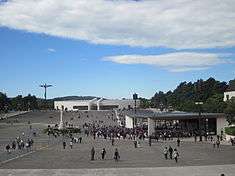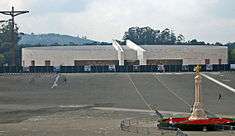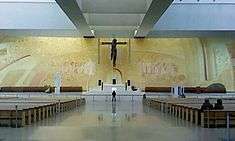Church of the Santíssima Trindade (Fátima)
| Church of the Santíssima Trindade (Igreja da Santíssima Trindade) | |
| Church of the Holy Trinity, Basilica of the Holy Trinity | |
| Church (Igreja) | |
_-_Jul_2008.jpg) The austere, simple facade of the Modernist Church and Minor Basilica of the Holy Trinity | |
| Official name: Igreja da Santíssima Trindade no Santuário de Fátima/Basílica da Santíssima Trindade | |
| Named for: Holy Trinity | |
| Country | Portugal |
|---|---|
| Region | Centro |
| Subregion | Médio Tejo |
| District | Santarém |
| Municipality | Ourém |
| Location | Fátima |
| - elevation | 358 m (1,175 ft) |
| - coordinates | PT 39°37′45.5″N 8°40′33″W / 39.629306°N 8.67583°WCoordinates: PT 39°37′45.5″N 8°40′33″W / 39.629306°N 8.67583°W |
| Length | 95 m (312 ft), Northwest to Southeast |
| Width | 115 m (377 ft), Southwest to Northeast |
| Height | 20 m (66 ft) |
| Area | 35,673 m2 (383,981 sq ft) |
| Architects | Alexandros N. Tombazis |
| Style | Modern |
| Material | Masonry stone |
| Origin | 1996 |
| - Initiated | February 2004 |
| - Completion | 2007 |
| Consecration | 12 October 2007 |
| Owner | Portuguese Republic |
| For public | Private |
| Visitation | Intermittent (Church is open irregularly, although not specifically for independent visits) |
| Easiest access | Rua João Paulo II; Rua Cónego Nunes Formigão |
| Management | Sanctuary of Nossa Senhora do Rosário de Fátima |
| Operator | Roman Catholic Diocese of Leiria-Fátima |
| Status | Unclassified |
| Listing | Zona "non-aedificandi" of the Sanctuary of Fátima (IPA.00020204/PT031421060020); pre-inventory register of elements in the location, designation and use towards official heritage classification. |
| Wikimedia Commons: Igreja da Santíssima Trindade, Fátima | |
| Website: http://www.santuario-fatima.pt | |
The Church of the Santíssima Trindade (Church of the Holy Trinity), officially the minor Basilica of the Holy Trinity (Portuguese: da Santíssima Trindade, is a Roman Catholic church and minor basilica in the Sanctuary of Fátima (Shrine of Our Lady of Fátima) in the civil parish) of Fátima, in the municipality of Ourém in Portugal.
In 2009 it received the Outstanding Structure Award by the International Association for Bridge and Structural Engineering,[1] which aims at recognizing the most remarkable, innovative, creative or otherwise stimulating structure completed within the last few years.[2]
History


In 1953, the basilica of Our Lady of the Rosary of Fátima (Portuguese: Basílica de Nossa Senhora do Rosário de Fátima) was consecrated.[3]
Situated on the southeast corner of the church, statue of Pope Pius XII (sculpted in white marble by Portuguese sculptor Domingos Soares Branco) was first revealed to the public, in a ceremony that included a formal blessing.[3]
A statue of Pope Paul VI was erected in May 1968 (authored by Portuguese sculptor Joaquim Correia) on the northwest corner of the church.[3]
During the 1973 liturgical year there were reports of the site's incapacity to support pilgrims on days of relatively minor volumes at the basilica.[3] This was made clear with the inauguration of a restored statue of D. José Alves Correia da Silva, first bishop of the Diocese of Leiria (by Joaquim Correia), on 2 February 1973.[3]
In 1974 the first steps towards resolving the influx of pilgrims occurred with the elaboration a pastoral program that included a new large covered assembly, by the rector of the sanctuary, Monsenhor Luciano Guerra.[3] But, the elaboration of a construction project for a new church was only initiated in 1996.[3] In the meantime, new religious symbols and reliquaries were added to the sanctuary, including a silver ostensorium by sculptor Zulmiro de Carvalho, in the main chapel of the Holy Sacramento (Portuguese: Capela do Santíssimo Sacramento).[3]
The plans to construct the new church were elaborated in 1996.[3] In 1997, the sanctuary organized an international competition for proposals the new church: the international jury selected the design of Greek architect Alexandros Tombazis on 19 December 1998. The work on the new church began in February 2004, with the cornerstone installed on 6 June of the same year.[3][4][5] The first stone, laid by retired bishop of the Diocese of Leiria-Fátima, Serafim Ferreira e Silva, was blessed and donated by Pope John Paul II on 9 March 2004, from a marble fragment of Apostle Peter's tomb, located under the basilica in Rome.[4] This was only a symbolic act, as the stone was later placed on display for visiting pilgrims within the finished church.[4]
The church was dedicated on 12 October 2007, in the company of Cardinal Tarcisio Bertone, Secretary-of-State for the Vatican and then-legate to Pope Benedict XVI, as part of the closing ceremonies dedicated to 90th anniversary of the Marian apparitions of Fátima.[3][5][6]
On 2 June 2008, the inauguration of the 14 stations of the Via Lucis, executed by Italian artist Vanni Rinaldi.[3] At the same time, a 3-metre (9.8 ft) image of Nossa Senhora de Fátima (located in the interior of the church) of Carrara marble was executed by Italian sculptor Benedetto Pietrogrande.[3] From 2008 several artistic projects were carried out by various international contributors.[3][6] Large 500 square metres (5,400 sq ft) gilded terracotta panels in the presbytery, by a group of artists specializing in liturgical art were painted; from eight nations and four Christian churches, based in the Pontifical Oriental Institute in Rome, the work was authored by Slovenian artist Marko Ivan Rupnik.[3][6] On the walls of confessional, azulejo panels, representing the episodes in the life of saints Peter and Paul, by architect Álvaro Siza Vieira were mounted.[3][6] A statute of Pope John Paul II, located to the northeast of the church, by Polish sculptor Czeslaw Dzwigaj was also added to the grounds in 2008.[3][6] A weathered steel cross, located in the church interior, approximately 34 metres (112 ft) high and 17 metres (56 ft) wide was mounted at that time by German sculptor Robert Schad.[3][6] A suspended sculpture by Cypriot artist Maria Loizidou was placed in the entrance portico, while the execution of the 8-metre (26 ft) doors in bronze, and panels from the Rosary, by Portuguese artist Pedro Calapez, were also completed; and 8-metre (26 ft) lateral doors in bronze, dedicated to the twelve apostles of Christ, with text by Portuguese artist Francisco Providência, were installed.[3][6] Meanwhile, stained glass panels with Bible verses in six languages were installed by Canadian artist Kerry Joe Kelly, and a bronze crucifix, suspended over the main altar by Irishwoman Catherine Green.[3][6]
On 19 June 2012, the Congregation for Divine Worship and the Discipline of the Sacraments sent word that the church would be elevated to the status of minor basilica, which came into effect on 13 August 2012.[3]
Architecture

_-_Jul_2008.jpg)
_-_Jul_2008.jpg)
During two years of construction, the Church of the Santíssima Trindade was designated GECA, for Grande Espaço Coberto para Assembleias (Great Covered Space for Assemblies), owing to its relative importance.[5][7] Due to its place, not just for the sanctuary, the church and the town, a dialog was established with the local authority to study the best urban solution for its location.[7] The area of Avenida D. José A. C. Silva was lowered in front the sanctuary, and a competition introduced into the urban area a pedestrian zone from Rua S. Vicente de Paulo and Avenida João XXIII, transforming this area into a boulevard, reducing transit and providing an artistic touch to the subterranean landscape. These change would result in the transformation of Fátima into a destination for pilgrims.[7]
The church is situated on the axis of two great roads in Fátima: north-south, a courtyard and extension to the south with the Pastoral Centre until Avenida João XXIII and east-west, Avenida D. José A.C.Silva.[7] The church is located in the southeast corner of the sanctuary of Fátima.[3]
During the analysis and revision of Alexandros Tombazis's original project, several modifications were made, of which was the creation of a space (a foyer) designated the Convivium de Santo Angostinho (Banquete of Saint Augustine) to be used when the GECA was used for congresses, meetings, musical concerts and small theatrical pieces.[7] In order to improve security and easy of access, many of the staircases for access and circulation, were replaced with gentle ramps.[7] The church's height was also increased from the earlier designs to make it less buried.[7] Although its capacity remained unchanged, with space for 9000 seated, the extra space to handle a standing-room crowd was rejected since it offered uncomfortable conditions for the users.[7] In the end, 8633 seats, including 76 spaces for people with difficult motor-control or handicapped.[8]
The plan of the building is marked by a gentle slope, permitting a good visibility of the altar from every angle.[8] The interior is divided into two sectors, accomplished by a 2 metres (6.6 ft) partition: the first section has seating for 3175 people (in addition to 58 spaces for handicapped); the second has 5458 spaces (with 18 for handicapped). Meanwhile, the presbytery has a capacity for 100 celebrants.[8]
The structure include several chapels: the Chapel of the Sacred Heart of Jesus (Portuguese: Capela do Sagrado Coração de Jesus), with 16 confessionaries; the Chapel of the Immaculate Heart of Mary (Portuguese: Capela do Imaculado Coração de Maria), with 12 confessionaries; the Chapel of the Resurrection of Jesus (Portuguese: Capela da Ressurreição de Jesus), with space for 200 and 16 confessionaries; Chapel of the Death of Jesus (Portuguese: Capela da Morte de Jesus), with space for 600; and the Chapel of the Holy Sacrament (Portuguese: Capela do Santíssimo Sacramento), dedicated for Lausperene, a maximum of 200 continuous prayer venerates.[8]
The simple modernist design is both functional and iconographic to develop a perception that is intuitive about its religiosity.[7] This is represented artistically from the main portico, the Door of Christ which brings attention to the transcendency of God and, effectively, it represents the themes of Father, Son and Holy Spirit with iconic imagery.[7]
Upon entering the assembly area is the presbytery at the end of the church, with the large crucifix and a large panel in mosaic representing a scene from the Apocalypse.[7] Most of the interior decoration, including stations of the cross were selected to provide a representation of internal journey of self-sacrifice.[7] This also includes a reference to the message of the Marian apparitions: penitence.[7]
See also
References
- Notes
- ↑ http://www.iabse.org/IABSE/association/Organisation_files/Outstanding_Structure_Award/The_Church_of_the_Most_Holy_Trinity__Fatima__Portugal.aspx
- ↑ http://www.iabse.org/IABSE/association/Award_files/Outstanding_Structure_Award/OStrA.aspx
- 1 2 3 4 5 6 7 8 9 10 11 12 13 14 15 16 17 18 19 20 21 22 Ferreira, Teresa (2012), SIPA, ed., Igreja da Santíssima Trindade no Santuário de Fátima/Basílica da Santíssima Trindade (IPA.00033410/PT031421060209) (in Portuguese), Lisbon, Portugal: SIPA – Sistema de Informação para o Património Arquitectónico, retrieved 8 December 2013
- 1 2 3 "Basílica da Santíssima Trindade" (in Portuguese). Fátima (Ourém), Portugal: Santuário da Fátima. 2004. Retrieved 8 December 2013.
- 1 2 3 Luciano Guerra (13 August 2007), p.1
- 1 2 3 4 5 6 7 8 Luciano Guerra (13 August 2007), p.3
- 1 2 3 4 5 6 7 8 9 10 11 12 13 "Basílica da Santíssima Trindade: Igreja da Santíssima Trindade – Considerações do arquitecto director do SEAC" (in Portuguese). Fátima (Ourém), Portugal: Santuário da Fátima. 19 October 2007. Retrieved 8 December 2013.
- 1 2 3 4 "Basílica da Santíssima Trindade: Capacidade: Igreja e Capelas" (in Portuguese). Fátima (Ourém), Portugal: Santuário da Fátima. 19 October 2007. Retrieved 8 December 2013.
- Sources
- Guerra, Luciano (13 August 2007), We are about to inaugurate the Church of the Most Holy Trinity (PDF) (14), Fátima (Ourém), Portugal: Shrine of Our Lady of the Rosary of Fátima (Portugal)
- Tombazis, Alexandros (2007). Libro S.A., ed. Fátima. Athens, Greece. ISBN 960-490-106-0. OCLC 298694502.